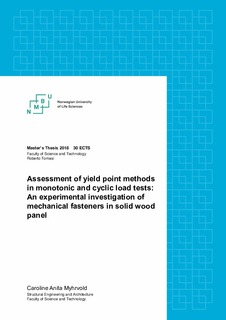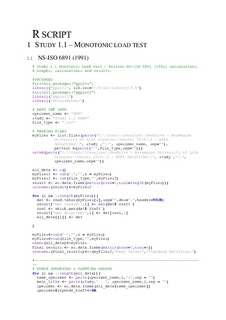| dc.description.abstract | Nowadays, there are several proposed methods of deciding the yield point when calculating the results from an experimental research on timber structures with mechanical fasteners. How does this affect the analysis of the timber product and how are these methods compatible with today’s possibility of computer programmes to calculate results? For this thesis, these questions served as guidelines during a product test, testing different configurations on sill connectors in solid wood panel with monotonic and cyclic load test. Results have been calculated from three different yield point methods, using the Yasumura and Kawai (Y&K) method, method (b) from NS-EN 12512 (2002) and the EEEP curve method. These methods are compared to evaluate their effect on the ductility value of the product. In addition, were the calculations done with the software programme R, checking how adaptable these yield point methods are.
This thesis is divided into two phases. First, an experimental phase and second, a calculation phase. The experimental phase consists of three stages where the first stage was the preparation of the experiment, the second was the assembly of the specimens and lastly the testing stage. For the calculation phase was a draft proposal of the revision on NS-EN 12512 accessible, facilitating a review of the proposal draft. Furthermore, an R script was written for each study divided by the three standards that where calculated (i.e. NS-ISO 6891 (1991), NS-EN 12512 (2002) and EN 12512 (2018) Draft proposal Version n°20180410). A comparison of standards was derived from the calculations, which includes a view on how they affect the stiffness, yield point and ductility values of the tested product.
The evaluation of the different methods shows the same trends as discussed from literature. The results retrieved from the calculations used by the newest proposal draft shows approximately the same ductility values in cyclic load tests than what the results from the current standard yields. In addition, was the runtime for the R script when calculating with the EEEP curve method much more efficient than for other methods.
The R script for each study is included as an attachment, while a scripted version verified on an external dataset is inserted in the appendix. | nb_NO |


